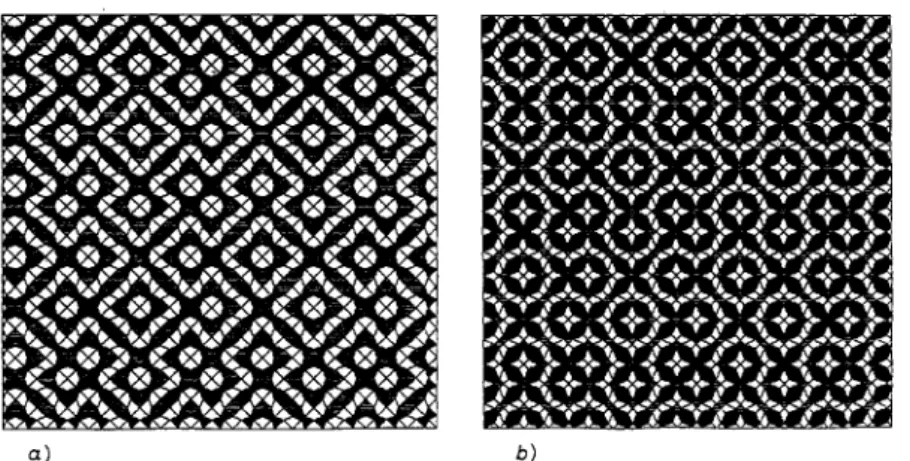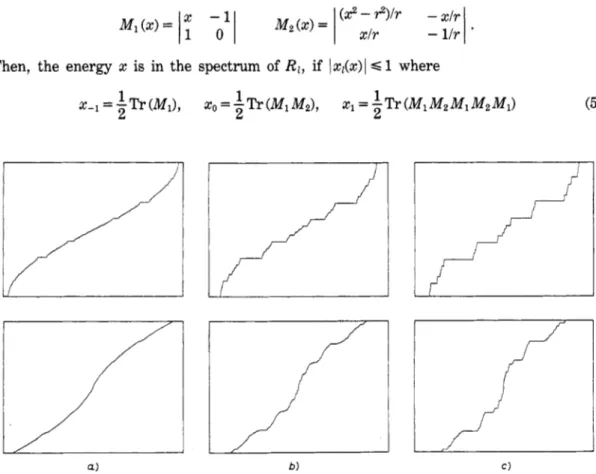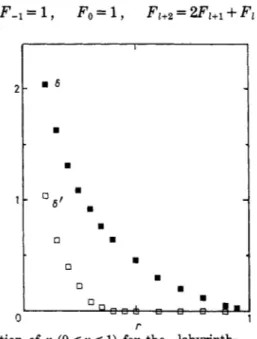HAL Id: hal-00472630
https://hal.archives-ouvertes.fr/hal-00472630
Submitted on 12 Apr 2010HAL is a multi-disciplinary open access archive for the deposit and dissemination of sci-entific research documents, whether they are pub-lished or not. The documents may come from teaching and research institutions in France or abroad, or from public or private research centers.
L’archive ouverte pluridisciplinaire HAL, est destinée au dépôt et à la diffusion de documents scientifiques de niveau recherche, publiés ou non, émanant des établissements d’enseignement et de recherche français ou étrangers, des laboratoires publics ou privés.
Electronic Spectrum of a 2D Quasi-Crystal Related to
the Octagonal Quasi-Periodic Tiling
Clément Sire
To cite this version:
Clément Sire. Electronic Spectrum of a 2D Quasi-Crystal Related to the Octagonal Quasi-Periodic Tiling. EPL - Europhysics Letters, European Physical Society/EDP Sciences/Società Italiana di Fisica/IOP Publishing, 1989, 10, pp.483-488. �10.1209/0295-5075/10/5/016�. �hal-00472630�
Electronic Spectrum of a 2D Quasi-Crystal Related to the Octagonal Quasi-Periodic Tiling
This article has been downloaded from IOPscience. Please scroll down to see the full text article. 1989 Europhys. Lett. 10 483
(http://iopscience.iop.org/0295-5075/10/5/016)
Download details:
IP Address: 130.120.231.223
The article was downloaded on 12/04/2010 at 16:35
Please note that terms and conditions apply.
The Table of Contents and more related content is available
EUROPHYSICS LETTERS
Europhys. Lett., 10 (51, pp. 483-488 (1989)
1 November 1989
Electronic Spectrum of a 2D Quasi-Crystal Related
to the Octagonal Quasi-Periodic Tiling.
C. SIRE
Laboratoire de Physique des Solides-C. N . R .S.
1 , place Aristide Briand, 92195 Meudon, France
(received 26 June 1989; accepted in final form 16 August 1989)
PACS. 71.20 - Electronic density of states determinations (inc. energy states of liquid PACS. 71.25C - Techniques of band-structure calculation (general theory, applications of
semiconductors).
group theory, analytic continuation, etc.).
Abstract. - Recently, a tiling derived from the well-known 2D quasi-periodic octagonal tiling has been introduced. In this letter, we show that in the framework of a tight-binding model, the electronic spectrum of this nontrivial tiling can be derived. The integrated density of state is singular and can be a devil staircase, there can be a finite or infinite number of gaps, whereas the measure of the spectrum can be zero or not, all these properties depending on the hopping parameters. This transition is explained with a very simple model.
1. Introduction.
Since the discovery of quasi-crystals by Schechtman et al. [l], many authors are interested in the study of the electronic spectrum in solids with a quasi-periodic structure, in one, two or three dimensions. In all dimensions, there are a lot of numerical works, which shows that the electronic spectrum of a quasi-crystal has a singular part [2]. The 1D case has been intensively studied [3-51, whereas in 2D or 3D, there are very few exact results, except for superlattices built from the Fibonacci sequence studied by Ueda and Tsunetsugu [6]. In the following, we introduce a tiling closely related to the 2D-octagonal quasi-periodic tiling, and study its spectrum.
2. The labyrinth.
Recently, a new tiling, we call it the labyrinth, has been introduced[7]. It is built univoquely from the quasi-periodic octagonal tiling. More precisely, it can be considered as a subset of the octagonal tiling, and conversely. It is built with a kite, a trapezoid and a square whose dimensions are functions of a certain parameter a (seer71 for more details). For a = 1
+
@,
we obtain the labyrinth which can be found directly, starting from the octagonal quasi-periodic tiling. We show the labyrinth in fig. 1, for different values of a. The origin of its name is manifest. We give the two main results which will be useful in the following. The coordinates of the vertices of the labyrinth ( a = 1+
@>
can be exactly derived and can be484 EUROPHYSICS LETTERS
a ) b )
Fig. 1. - The labyrinth for different values of a. a) a = 1
+
.\/2,
b ) a < 1 (here, a =.\/2
- 1). written aswhere F ( x ) is the closest integer to
x
and 1, m E 2. It is clear from (1) that the labyrinth hasan average lattice (which is a square lattice), by taking F ( x ) =
x.
Moreover, it can be shown that the labyrinth can be obtained in a different way. Let us consider S l , a sequence of letters L and S (the aOctonaccin sequence), obtained by means of the following recursion formula:
S o = S , S 1 = L , S l + e = S 1 + l * S l * S l + l and Sm=l&S1,
where
*
is a symbol for chain concatenation. One can associate a linear chain to S1 (we call itR J
by associating a length 1 to a S and a length a to a L , and symmetrizing it with respect to the origin. Now, we build the Euclidean product R , x R,, and remove all vertices which cannot be linked to the origin by means of diagonal bonds (that is nonvertical nor horizontal bonds). Finally, if we link nearest neighbours by diagonal bonds, we recover the labyrinthFig. 2. - The labyrinth as it is built in sect. 3-4. The dotted lines represent the underlying Euclidean product.
C. SIRE: ELECTRONIC SPECTRUM OF A 2D QUASI-CRYSTAL ETC. 485 (fig. 2). This last method will be very useful in order to derive the electronic properties of the 'labyrinth.
3. The product of two linear chains.
Let us consider two linear chains of atoms, S1 and S,. One can study the electronic spectrum of each chain in the framework of a tight-binding model. We suppose that on Si,
i
= 1 , 2 , the hopping parameter between nearest neighbours can take only two values, si and Zi. Of course, this condition is not necessary and the following calculation is not affected by a biggest set of values for the hopping terms. Moreover, for Si, we take the diagonal terms of the Hamiltonian equal tovi,
i
= 1,Z. Now, suppose we know the electronic spectrum and the wave functions for each linear chain:where Ei
+
vi is in the spectrum of S i , and @i,j is the eigenvector value at the site j ofSi.
Bydoing the product of two such equalities (one for each chain), we obtain
with
and the sum holds on the eight nearest neighbours of the site (i,j). We introduced an arbitrary constant V whose dimension is an energy, for E to have the same dimension. We see that the eight hopping parameters are not independent, since they are functions of only six independent ones. So, we can build the spectrum of a lattice with rather complicated interactions, provided we can find linear chains whose spectrum is known, starting from which the lattice can be built. The same calculation can be done in 3D or with second nearest neighbours.
Let us study two particular cases. The first one is well known, and corresponds to the case where we take w1 = v, = V and V =
+
CQ. Then, we obtain the usual Euclidean product ofthe linear chains. Of course, in that case, the formula (3) for the energy gives E = E l
+
E2,'* which is a classic result. A more interesting result is obtained when taking vl = v2 = 0. In that case, one can see that vertices linked by a vertical or horizontal bond in the Euclidean product S1 x Se do not interact any more, since the hopping parameter for such bonds is in the set {wlsz, v1Z2, v2s1, vzZ,}. More precisely, if we link together every couple of interacting sites on SI x S,, we obtain two superimposed and connected set of vertices, each of them being the dual of the other one (fig. 2). If we take one vertex of S1 x Se as the origin, we can see that the first lattice contains vertices whose coordinates have the same parity, while the other one consists in vertices with coordinates with opposite parity. Even if the resulting tiling is not necessarily identical to its dual, they have the same spectrum, since (2) and (3) split in two disconnected sets of equations. Nevertheless, there is no reason for a simple correspondence between both wave functions. Moreover, the spectrum of each lattice is the set {E,E,,
El E Sp (SJ,E,
E Sp (S,)}, where Sp (Si) is the spectrum of S,.486 EUROPHYSICS LETTERS
4. The electronic spectrum of the labyrinth.
In (l), let us define p and q by p = 1
+
m and q = E - m. Then, the coordinates can be expressed in an equivalent way byMoreover, it can be shown that the sequence of long and short lengths along the chain U = { U p , p E Z} is identical to R,. Thus, the labyrinth consists in the vertices of the
Epclidean product
U
x U whose coordinates have the same parity (fig. 2). According to sect. 3, if we know the spectrum of the linear chain U , we also know the electronic spectrum of the labyrinth and its dual. So, let us study the spectrum of U . Since U has the same structure asR,, which follows the Octonacci sequence, we first study the spectrum of a crystal of elementary cell Rl, before taking 1 infinite. Then, our problem becomes very similar to a tight-binding model on the Fibonacci chain. We expect to find a trace mapping whose iterations will lead to the spectrum. Indeed, very similar calculations as those done in [41 give the following result. Let the hopping parameter be 1, for a long bond, r, for a short one. We define Ml(x) and M&) by
Then, the energy
x
is in the spectrum ofR1,
if)xL(x)I
S 1 where 1 x-l = -Tr ( M J , 27
/ Q ) b )l i ’
Fig. 3. - We show, respectively, the IDOS of the Octonacci chain (up) and the IDOS of the labyrinth, for a) r = 0.8 (no gap, finite measure), b) r = 0.6 (some gaps and finite measure) and c ) r = 0.3 (infinity of gaps and zero measure). The energy varies between - 2 and 2, since v < 1.
C. SIRE: ELECTRONIC SPECTRUM OF A 2D QUASI-CRYSTAL ETC. 487 and x1 obeys the following recursion formula:
x1+3 = 4(x1+2)2 xE+1 - ($1 -k x1+2) %+d%+1 - x1+1* (5')
Taking into account this last result, and the derivation of sect. 3, we are now able to calculate the DOS (density of state) for the labyrinth with hopping parameters 1, r, ?, for the three kinds of neighbouring sites. In fig. 3, we show the integrated DOS for the Octonacci chain and the labyrinth, for three typical values of r. Note that for r close to 1, the IDOS of the labyrinth resembles the IDOS of a square lattice, without any visible gap, whereas for small values of r, large gaps are appearing and the IDOS is a devil staircase. One can be interested in the measure of the spectrum. More precisely, for the Fibonacci chain, Kohmoto has found that when the size of the elementary cell increases, the measure of the spectrum vanishes like Fi', where F1 is the number of atoms in
R1.
For the Octonacci chain, we obtain a similar result withr
Fig. 4. - 6 and 6' as a function of r (0 e r < 1) for the #labyrinth,.
For the labyrinth, we expect the measure of the spectrum to behave like Fi". In fig. 4, the dependence of 6 and 6' with r is shown for 0 S r
<
1. The first result is that although the DOS of the labyrinth is always singular, the measure of the spectrum is nonzero for r>
ro with ro = 0.4, zero otherwise. Moreover, there is an asymptotic relation between 6 and 6'. Indeed; for r close to 0, so that 6is large, each band of R1 is very thin. Therefore, the aproductw of the Flbands gives almost Ff bands in the spectrum, so that the total bands width is about Fi-'.
Hence, 6' = 6 - 1. Near rot a lot of bands overlap and this estimation is not correct.
One can illustrate the behaviour of the spectral measure, with a very simple example. Consider a real k > 3 , and the sets C , and C defined by
488 EUROPHYSICS LETTERS C, is a ramified set, and C is a Cantor set. The measure of C, is 2 x 3"lk". It goes to zero when n goes to infinity like 3-&, with
6
= In (k)/ln (3) - 1. Thus, the measure of C is zero. Moreover, one can cover C, by means of 3" segments of length 2Ik". Thus, the Hausdorff dimension of C is found to be lim [- In (3")/ln(2/kn)] = In (3)/ln(k). In general, the p - branches Cantor set has Hausdorff dimension ln(p)An(k), and the corresponding6
is In (k)An ( p ) - 1. C can modelize very grossly the spectrum of a 1D quasi-crystal (eventually with a different number of branches for an irrational number different from @ - 1 or(fi
+
1)12). In fact, it is known that instead of only one scaling factor k, there are an infinity of such ones [8] in the spectrum. Now, starting from C, we can build the two sets C, and C,defined by C , = {x
+
y/x,
y E C} and C, = {xy/ x, y E C}. Since C+'is a ramified Cantor setwith 5 branches, the associated S' is 6' = In (k)/ln (5) - 1, if k
>
5, zero otherwise, while the Hausdorff dimension is In 5/ln k. Thus, for such a set, even if the IDOS can be shown to be singular, the measure can be finite, or zero, if the scaling factor k becomes larger than 5. The Result for C, is exactly the same. Thus, we find that the measure of C, and C, becomes zero when 6, the exponent related to C, is cYc = In (5)fln (3) - 1. For a more general three- branches Cantor set, C, and C, are expected to be two six-branches Cantor sets andSe = In (6)fln (3) - 1 = 0.63093. Even if this crude treatment cannot describe rigorously the behaviour of the spectrum of Fibonacci or qOctonacci>> chains, it gives a reasonable value for cYC, and explains why the measure can be zero or not.
n-+-
5. Conclusion.
In this letter, the excitation spectrum of a 2D quasi-periodic tiling very closely related to the standard octagonal tiling is calculated. The density of states is singular. No gap can be seen when the hopping parameters are too close to 1. Moreover, the spectrum measure is finite for r sufficiently close to 1, and zero when r is smaller than a critical value. Such a phenomenon can be explained by a very simple model describing the spectrum as a ramified Cantor set.
* * *
I am very indebted to R. MOSSERI, J. BELLISSARD and M. DUNEAU for stimulating conversations.
REFERENCES
[l] SHECHTMAN D., BLECH I., GRATIAS D. and CAHN J. W., Phys. Rev. Lett., 53 (1984) 1951. [21 CHOY T. C., Phys. Rev. Lett., 55 (1985) 2915; TSUNETSUGU H., FUJIWARA T., UEDA K. and [3] AUBRY S. and ANDRE G., Ann. Israel Phys. Soc., 3 (1980) 133.
[4] KOHMOTO M., KADANOFF L. P. and TANG C., Phys. Rev. Lett., 50 (1983) 1870; OSTLUND S., PANDITT R., RAND D., SCHELLNHUBER H. J. and SIGGIA E..D., Phys. Rev. Lett., 50 (1983) 1873. [5] KALUGIN P. A., KITAEV A. Yu. and LEVITOV L. S., 2. Eksp. Teor. Fix., 91 (1986) 692. [61 UEDA K. and TSUNETSUGU H., Phys. Rev. Lett., 58 (1987) 1272.
[7] SIRE C., MOSSERI R. and SADW J. F., to be published in J . Phys. (Paris).
[81 LUCK J. M. and NIEWENHUIZEN T. M., Europhys. Lett., 2 (1986) 257. TOKIHIRO T., J . Phys. Soc. Jpn., 55 (1986) 1420.


